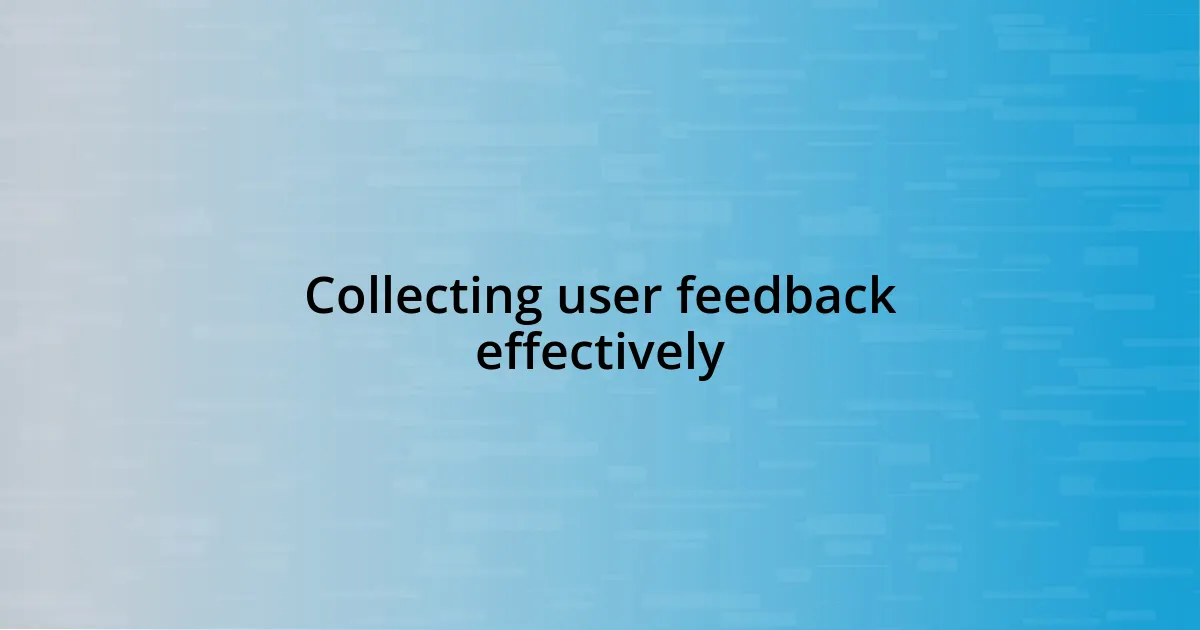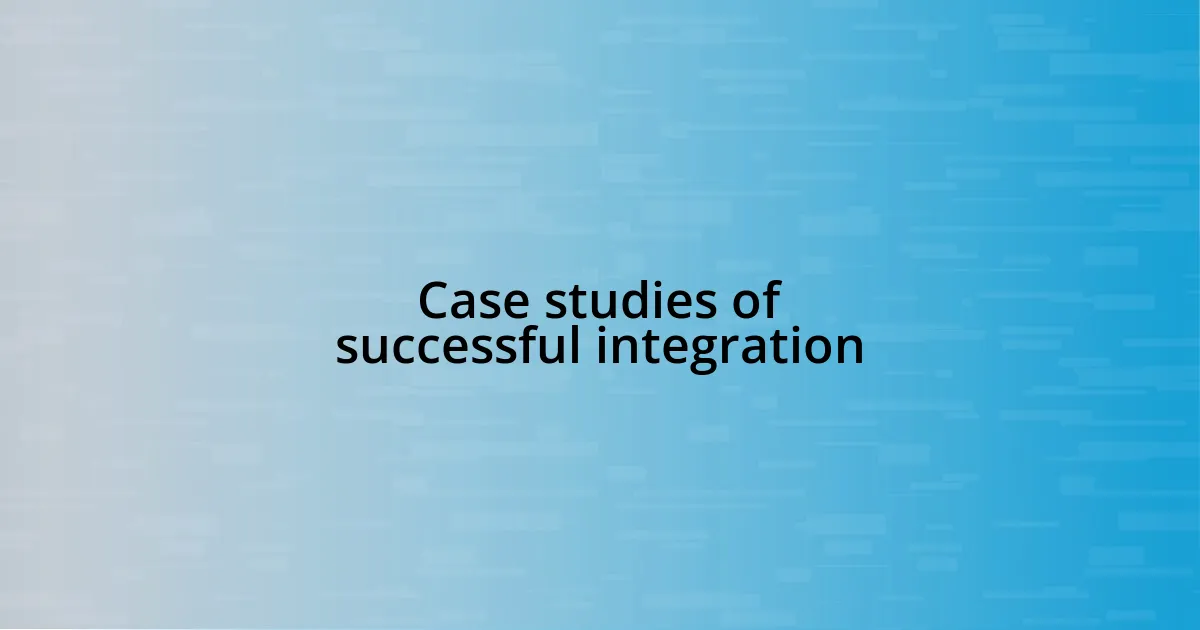Key takeaways:
- User feedback is a rich source of emotional insight; understanding the context behind feedback is crucial for impactful changes.
- Creating a comfortable environment and asking open-ended questions significantly enhances the quality of user feedback collected.
- Analyzing user feedback requires both quantitative data and an emotional connection to identify pressing issues effectively.
- Iterative design based on ongoing feedback fosters a deeper relationship with users and leads to meaningful product improvements.

Understanding user feedback process
The user feedback process is an ever-evolving journey that I find both fascinating and essential. I remember a time when I misunderstood a critical piece of user feedback, overlooking the emotional context behind it. This experience taught me that feedback isn’t just data; it’s a window into the user’s world and their feelings.
When I actively listen to users during feedback sessions, I often feel a mix of vulnerability and excitement. It’s like having a heart-to-heart conversation where they share their honest thoughts. Have you ever noticed how one heartfelt comment can illuminate an entire project? I’ve found that it’s the emotional stories behind the feedback that drive impactful changes.
Digging deeper into the feedback requires asking follow-up questions, which often leads to unexpected insights. For instance, I once probed a user about a minor feature complaint, only to discover it stemmed from a larger usability issue. This taught me the value of persistence—sometimes, the most enlightening details emerge when you dive deeper into the user’s narrative.

Collecting user feedback effectively
Collecting user feedback effectively requires a blend of strategy and empathy. I remember hosting a focus group where the initial silence was deafening. I felt a pang of anxiety, fearing that my efforts to gather feedback would flop. However, once I initiated an open-ended discussion, the floodgates opened. Users began to share their experiences and frustrations. That moment taught me that creating a comfortable environment encourages genuine and valuable feedback.
Here are some strategies I’ve found helpful in collecting user feedback:
- Create a welcoming atmosphere: Ensure users feel safe to express their thoughts.
- Ask open-ended questions: This fosters deeper insights and encourages storytelling.
- Use multiple channels: Surveys, interviews, and focus groups can capture a diverse range of opinions.
- Actively listen: Show genuine interest in their responses without interrupting.
- Follow up on their recommendations: Let users know their feedback leads to real changes, building trust in the process.
These approaches not only yield richer feedback but also create stronger connections with users.

Analyzing user feedback insights
Analyzing user feedback insights is like piecing together a puzzle with each comment adding context and depth. I recall a time when I first started examining feedback in detail; I was shocked at how a simple trend could reveal profound insights. For example, users frequently mentioned difficulty navigating a specific feature. Initially, I dismissed it as a simple preference, but my analysis showed it represented a broader usability issue that, once addressed, significantly improved user satisfaction.
As I delved deeper, I realized that categorizing feedback by themes was immensely helpful. This method allows me to see which issues are most pressing and how they align with user needs. I remember creating a spreadsheet to group feedback, and the clarity I gained was incredible. I could see patterns emerging that guided our development priorities. It’s a rewarding feeling when data transforms into actionable insights.
Ultimately, the process is both analytical and intuitive. Yes, I rely on metrics, but I also trust my gut feeling about certain feedback. I vividly recall a user expressing frustration in a tone that struck a chord with me—her comments felt raw and genuine. That emotional connection made me prioritize that feedback, leading to swift changes that resonated with users. It’s amazing how the heart and data can work together in this analysis.
| Analysis Method | Description |
|---|---|
| Pattern Recognition | Identifying recurring themes from user feedback to focus on the most critical issues. |
| Sentiment Analysis | Evaluating the emotional tone of user comments to better understand user feelings. |

Implementing feedback into design
Incorporating user feedback into design is not just a task; it’s an ongoing journey that requires both patience and precision. I vividly remember a time when we launched a feature that we thought was groundbreaking. However, within days, feedback came flooding in, revealing that users found it confusing. It felt like a gut punch, but instead of ignoring the comments, I embraced them. By redesigning the feature based on user suggestions, we transformed a disappointment into a success story.
When I’m faced with user feedback, I often ask myself: “How can I turn these insights into design improvements?” This reflection has led me to implement practical changes, like sketching out wireframes based on what users actually want. For instance, one user pointed out that the buttons were hard to find. I created more prominent buttons and tested them again. The difference was night and day. Users felt more empowered and engaged, which proved that their voices can genuinely guide design decisions.
I’ve also learned that implementing feedback shouldn’t be a one-and-done approach; it’s about iterating and evolving. I recall collaborating closely with developers to integrate user-identified issues into the design roadmap—a process that felt like teamwork in its purest form. Whenever we rolled out a new design, I’d watch user interactions carefully, anticipating their reactions. This hands-on approach offered me a fulfilling sense of connection, as I witnessed firsthand how feedback could breathe new life into our designs. It’s a powerful reminder that user feedback is the lifeblood of truly effective design.

Measuring impact of changes
Measuring the impact of changes can sometimes feel like navigating uncharted waters. I remember implementing a significant redesign and eagerly watching the user engagement metrics post-launch. Initially, I felt optimistic but, as the early data rolled in, there was a surprising dip in usage for the feature I believed would shine. This moment of vulnerability reminded me that changes often need time and adjustment before they are fully appreciated by users.
Reflecting on this experience, I found that using a mix of qualitative and quantitative feedback was crucial. When I dived into user surveys alongside analytics, patterns emerged that gave me deeper insights. One user bluntly stated, “What was wrong with the old version?” Their honesty led me to realize that not all changes are clear-cut improvements; some users have a strong attachment to familiar designs. This kind of feedback is vital—it’s not just about the numbers but also the feelings users have toward the changes we implement.
To truly measure impact, I’ve learned to establish benchmarks beforehand. This way, I have a tangible baseline from which to evaluate success. I still recall setting specific KPIs for a feature update and continually revisiting them to assess our progress. It’s like standing on a cliff and looking out to see if the view has improved. This foresight not only guides future decisions but also fuels a proactive approach to integrating feedback throughout the design process. Have you ever felt that moment when you realize the satisfaction of your users can light the way forward? That’s the impact we’re all striving for.

Iterating based on ongoing feedback
Feedback isn’t just a checkmark on a to-do list for me; it feels like an ongoing dialogue with my users. I remember a project where we launched a new navigation flow that seemed intuitive, yet the moment the users interacted with it, I noticed a flood of emails indicating they were lost. The initial shock of the negative feedback stung, but I saw it as a golden opportunity. By scheduling feedback sessions and directly asking users where they struggled, we cultivated insights that not only reshaped the navigation but deepened our relationship with the community.
As we started implementing requested changes, I made it a point to keep the feedback loop active. After each iteration, I’d reach out to those users again, asking specific questions about their experiences with the updates. One insightful user shared that even small text changes made a significant difference in their overall comprehension. I never realized how much details matter until that conversation. This iterative process brought me face-to-face with the essence of user-centric design; every conversation felt less like gathering data and more like having a heart-to-heart with trusted friends about their needs and desires.
There’s a certain thrill in witnessing firsthand how feedback leads to growth. In one instance, we modified a feature that was initially branded as “innovative” but fell flat. Following a series of adjustments from user insights, it transformed into something they adored. I often reflect on whether we could have shortened this feedback cycle if we had prioritized user input from the onset. Would it have saved us time and energy? It’s a question that humbles me, reminding me that iteration based on ongoing feedback is not a mere tactic; it’s a crucial philosophy that nurtures both the product and the community around it.

Case studies of successful integration
In one of my favorite projects, we faced a major hurdle when integrating user feedback for a mobile app redesign. During a beta test, users voiced concerns that the new layout made it harder to access frequently used features. It felt disheartening at first, as I had poured my heart into this design, but the feedback was invaluable. I gathered the team for a brainstorming session, where we transformed those critiques into actionable changes, ultimately leading to a layout that balanced aesthetics with usability. It was a powerful reminder that listening can sometimes feel like stepping back, but it often propels us forward in ways we didn’t foresee.
Another standout experience was when we overhauled our onboarding process after receiving feedback that it felt overwhelming. Instead of confining users to lengthy tutorials, we integrated in-app tips that guided them through features. I remember receiving a message from a user who exclaimed, “I actually enjoyed learning how to use this app!” That moment was one of pure joy for me; it reinforced my belief that our role is to empower users rather than burden them. I can’t help but wonder—how many other experiences have I transformed just by sitting down and listening?
Then there was a time when we launched a feature that users loved but felt it could be enhanced with a simple addition. It was a minor tweak, but the impact was profound. Users appreciated that we took their suggestions seriously, which built a sense of community around our product. Their involvement strengthened the user experience tremendously, and I often think, what if every company prioritized this level of collaboration? The lessons here resonate far beyond project timelines; they echo in the relationships we build with our users.














